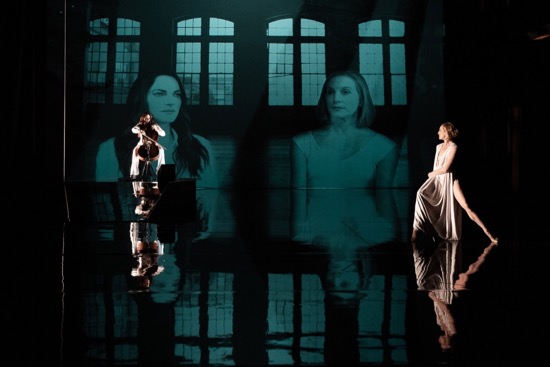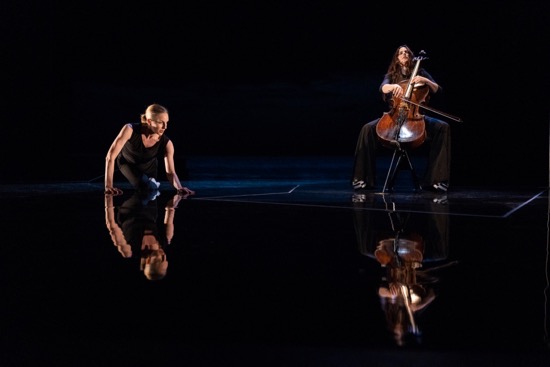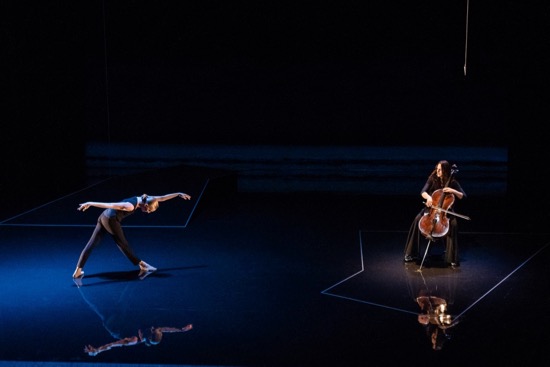
I didn’t read Maura Keefe’s program essay while sitting in Jacob’s Pillow’s Doris Duke Theater, waiting for the day to start. I didn’t read the program note by the versatile and highly regarded cellist Maya Beiser. I didn’t read the spoken text that was part of David Lang’s score. And, once the piece began, I didn’t identify one of the projected slides as showing Santiago Calatrava’s Oculus structure at the World Trade Center before it fell. Why then, did I find tears pricking at my eyes as the piece neared its end? Perhaps because of the subtly powerful merging of music and image.
The music for the day is the 2016 prequel to the 2001 world to come, both of which were heard at the Pillow. Lang and Beiser were working on the second score when the World Trade Center’s twin towers fell. We hear both compositions, played onstage by the marvelous Beiser while we watch the equally marvelous Wendy Whelan perform Lucinda Childs’s spare, elegant choreography. There’s no anguish, no falling bodies, no terror. It’s as if we’re watching the ultimate fragility of structures that we take for granted.

The scenic design by Sara Brown makes the floor as reflective of Natasha Katz’s lighting as still water. When Whelan reaches a hand down toward it, its mirror image rises as if their fingers mean to touch. White tape traces a polygon on one side of the black stage floor. Further away on the other side is a shallow, white-edged black ramp. A chair sits on each.
During Part 1: the day, both women wear white. Karen Young garbed Whelan in a complex drapery that exposes some flesh and bells out around her when she spins. After a while, she removes the outer part of it and folds it carefully. To help us better understand the text-music congruence, closeups of Beiser’s and Whelan’s heads and upper bodies appear in black-and-white video, in front of an empty, windowed dance studio. They take turns speaking lines from the text. Here’s an example that I heard:
I decided to make a significant change in my lifestyle I/ decided to move there for good/ I decided to quit/ I decided to run 18 miles I/ decided to start.
Lang crowd-sourced the text, sentence by sentence, from the Internet, working his way from “a” through “w” for the word following each “I.”

While Beiser plays her cello seated on the slanted platform, Whelan moves with quiet absorption, alert to things we cannot see. Dancing Childs’s choreography—her legs probing the space, twisting around each other, lunging out—she often seems to be slowly measuring unseen parts of the space with devices that she acquires: a slim rod, a silver loop. She reaches into the wings and brings out what could almost be a ghost— a sheet tied below a ball the size of a child’s head —and once walks with it attached to her back. She forms two slender sticks into a V. From the stage-left wing, white-clad hands give her the ends of two cords that she then pulls onto the stage. But she also handles invisible outlines—stretching her empty hands far apart, grasping something and pulling it toward her. In Joshua Higginson’s projections, objects that we see onstage may flash onto the backdrop.
When Beiser and Whelan return to the stage after a pause, both are dressed in black, and Whelan’s hair, loose in Part 1, is tied into a ponytail. Part 2, world to come, is darker, and you can begin to feel that the related, yet unrelated spoken phrases—some prosaic, some worried, some comical—are being delivered by souls being whirled through space.

The stage seems to have become a dangerous place. Beiser now sits in the floor-level area, and we hear not only her rich, fierce on-stage playing, but two recorded voices of her cello vying with it and cajoling it. Occasional thunder sounds. On the backdrop, a filmed cello slowly breaks and falls in pieces. The vision of an empty studio becomes one of sea and a sky of low clouds.
Twice, Whelan walks an invisible tightrope on her toes. You begin to see Childs’s sensitive, ingenious movement patterns being repeated. As world to come winds down, Whelan, standing on the ramp, pulls down the long piece of white fabric that has descended in front of her. On the backdrop, tinted greenish, images of two similar cloths appear: appallingly fragile towers, billowing as they fall. Whelan carefully lays out the real fabric and, rolls down the ramp, wrapping herself in it. That is, indeed, the end.
It’s strange to see massive upheaval transformed into such delicate abstraction, but the structure that these four collaborators have created make the instability of what we consider permanent terrifyingly clear.

So fascinating that the phrase that anchors Part I. ( “I remember the day when…” followed by the 300 pieces of text) is of course what we all say about 9/11, and if we are old enough, the day Kennedy was assassinated. It is, as you say, our way of measuring time and our place in it. The broken cello, whose form has always evoked the female body to me, can only be a piece of our memory: Childs, Whelan and Beiser are the living —and they are powerfully, thankfully, still here to create art.
Why did you find tears pricking at my eyes? Well, David Lang does that to people.